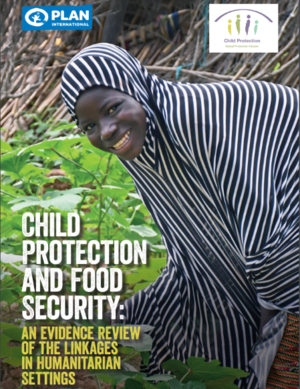Request tailored, remote support on child protection coordination, information management, and thematic areas.
Demander un soutien à distance sur mesure pour la coordination de la protection de l'enfance, la gestion de l'information et les domaines thématiques.
Solicite asistencia remota sobre coordinación en Protección de la Niñez, gestión de la información y otras áreas temáticas.
قم بطلب دعم مخصص عن بعد في أي من مجالات تنسيق حماية الطفل وإدارة المعلومات أو أي من مواضيع حماية الطفل الأخرى.
Integrating Child Protection and Food Security in Humanitarian Action
WHY CHILD PROTECTION AND FOOD SECURITY ARE LINKED
Conflict, climate shocks, and COVID-19 continue to increase food insecurity around the world, leaving an estimated 283 million people acutely food insecure or at high risk in 2021. Food insecurity erodes families’ resilience and forces them to use strategies that permanently undermine their future food security and their children’s protection and well-being.
Evidence shows that food insecurity leads to increased vulnerability for children, particularly girls. It can create and exacerbate child protection risks such as family separation, child labor, recruitment and use by armed forces and armed groups, psychological distress, neglect, child marriage, and other forms of sexual and gender-based violence.
A RENEWED GLOBAL INITIATIVE
The Global CP AoR and Plan International are launching a global initiative to enhance field support and coordination between child protection and food security sectors and promote shared outcomes for children. By working closely with country colleagues, CP AoR Help desks and Rapid Response Team, this initiative will provide practitioners with tools and resources to integrate child protection and food security responses. The initiative will document country case studies, develop programmatic tools and advocacy briefs, and provide technical support to humanitarian operations.
This initiative reinforces the centrality of child protection in humanitarian action and will contribute to Pillar Four: Working Across Sectors of the Minimum Standards of Child Protection in Humanitarian Action (CPMS).
FOR MORE INFORMATION
To learn more about the linkages between child protection and food security:
CHILD PROTECTION AND FOOD SECURITY: AN EVIDENCE REVIEW OF THE LINKAGES IN HUMANITARIAN SETTINGS

Child Protection Food Security Evidence Review
Food security is essential to children’s protection and well-being. Evidence shows that food insecurity negatively impacts children’s protection and well-being across humanitarian contexts. The Global Child Protection Area of Responsibility and Plan International are working in partnership to strengthen collaboration between child protection and food security actors. Based on academic and grey literature and key informant interviews, this document outlines how food insecurity affects children’s protection and well-being.
Findings show that children’s protection is affected in the following ways:
- Food insecurity is linked with poor mental health and psychosocial distress of children and caregivers. This triggers various forms of violence against children.
- When children and families do not have enough to eat or money to buy food, they may resort to extreme coping mechanisms
- Children are exposed to various child protection risks while producing, searching for, or preparing food.
- Interventions to address food insecurity can also expose children to various risks.
The evidence review can be accessed here and it includes examples of how Child Protection and Food Security actors are working together to address these issues and key recommendations for donors and humanitarian practitioners. The evidence review will also be made available in Arabic, French, Portuguese and Spanish.
Global event on how food security impacts children and their protection: A spotlight on impacted contexts and recommendations for urgent humanitarian action. Click here to access the presentation and recommendations from the event as well as other relevant documents.
For more information on the global initiative, please contact: Yang Fu, yang.fu@plan-international.org, Child Protection in Emergencies (Food Security) Specialist.
